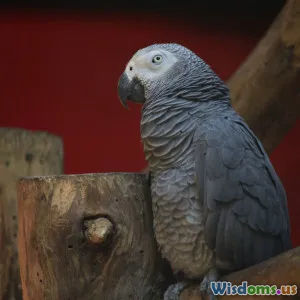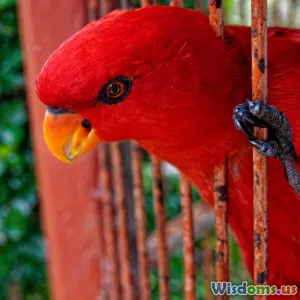
Why Some Birds Imitate Human Speech Better Than Others
8 min read Explore why certain bird species excel at mimicking human speech and the biology behind this fascinating skill. (0 Reviews)
Why Some Birds Imitate Human Speech Better Than Others
Birds that imitate human speech have captivated people’s imaginations for centuries. Whether it’s the mellifluous tunes of a parrot or the surprising chatter of a mynah bird, these avian vocalists can sound eerily humanistic. Yet, not all birds are equally talented voice mimics. Why do some birds imitate human speech better than others? The answer lies mostly in their distinctive biology, neural structures, and social behaviors. In this article, we’ll unpack the fascinating reasons behind this ability and use scientific insights, examples, and real-world observations to illuminate this remarkable skill.
The Anatomy of Birdsong: Vocal Apparatus Explained
When discussing speech mimicry, the key begins with anatomy. Birds produce sounds using an organ called the syrinx, located where the trachea meets the bronchi. Unlike the human larynx, the syrinx allows incredible versatility in producing sounds, sometimes enabling birds to produce two different notes simultaneously.
The Syrinx Advantage
Bird species that excel in mimicry typically have a more developed and flexible syrinx. Parrots, mynas, and starlings—known for their speech-like vocalizations—possess syrinxes with complex muscle structures that allow fine control of airflow and tone. For example, African Grey Parrots have exceptional muscular control of their syrinx, enabling nuanced sound production close to human tones.
In contrast, many bird species have simpler syrinx structures, producing limited sound variation focused mainly on natural calls for mating or warning, rather than mimicry.
Cognitive Ability and Vocal Learning
Mimicking human speech requires more than just the right vocal organ; it demands advanced brain function. Birds that imitate human speech have evolved specialized brain circuits called song control nuclei. These neural pathways govern vocal learning, memory, and sound replication.
Parrots and Songbirds: Neural Masters of Mimicry
Among the avian world, parrots and songbirds demonstrate the highest vocal learning capabilities thanks to well-developed song control systems. African Grey Parrots, for instance, show cognitive abilities on par with primates in some cases, recognizing human voices, understanding context, and even using words appropriately.
Research from the University of California shows that the brain regions involved in vocal mimicry in some parrots show enhanced activity when they hear and reproduce human speech patterns, indicating a deep neurological engagement beyond simple sound copying.
Other Species: Limited but Present Vocal Learning
Broader studies show that even some songbirds, like starlings and kookaburras, can imitate human sounds. However, their brains may lack the sophisticated song nuclei found in parrots, restricting their speech imitation to simpler phrases or melodies.
Social Context and Environmental Influence
Birds don’t just mimic speech instinctively—they often mimic sounds important in their environment.
Social Interaction Drives Mimicry
Parrots, for example, are highly social animals. In the wild, they use vocalization to communicate with flock members. When kept as pets, they may view humans as flock mates, mimicking their speech as a social bonding mechanism. This social motivation encourages more frequent and accurate speech imitation.

The African Grey Parrot is renowned for its remarkable ability to mimic human speech, owing to its social nature and advanced vocal anatomy.
Exposure and Learning Opportunities
Birds exposed to frequent human interaction tend to develop better imitation skills. For instance, a captive mynah bird raised around people can imitate speech more fluidly than a wild counterpart with no such exposure. Similarly, parrots housed in stimulating, noisy environments adapt by incorporating new sounds into their vocal repertoire.
Why Some Birds Struggle to Imitate
While some species excel, others rarely mimic speech. This comes back to evolutionary niche and survival priorities.
Evolutionary Pressures
Birds inhabiting dense forests or isolated regions tend to rely on species-specific calls advantageous for mating and territory defense. Mimicking foreign sounds may offer no survival value. Consequently, their vocal structures and brain programming reflect this selective need.
Limitations in Vocal Learning
Certain birds, like pigeons or raptors (hawks, eagles), have limited vocal learning ability. They lack the intricate song control nuclei and syrinx flexibility to mimic complex sounds like human speech. Their communication revolves mostly around innate calls encoded genetically, not learned sounds.
Real-World Examples Demonstrating Speech Imitation Skills
African Grey Parrot - The Gold Standard
This species is famous not only for reproducing words but for showing understanding. The late Alex, an African Grey Parrot studied extensively by Dr. Irene Pepperberg, could name colors, shapes, and even express emotions, indicating that mimicry can be linked with cognitive processing.
Hill Mynah Birds - Masters of Clarity
Hill mynahs are celebrated for crisp, clear human-sounding speech. They possess the right combination of syrinx structure and social environment influencing mimicry, popular among pet owners for this reason.
Budgerigars - Unexpected Mimics
Though smaller and less famous, budgerigars (budgies) can learn to mimic words and phrases, especially when trained from a young age. Their songbird roots give them some vocal learning ability, though less complex than parrots.
Conclusion: The Perfect Storm for Bird Speech Mimicry
The ability of some birds to imitate human speech better than others is a complex interplay of anatomy, brain capacity, social behavior, and environment. Birds endowed with a capable syrinx, sophisticated vocal learning brain centers, and a socio-environment that encourages vocal experimentation have evolved unique mimicry skills.
Understanding these factors not only sheds light on avian biology but also fosters greater appreciation for the intelligence and adaptability of these extraordinary creatures. Next time a parrot repeats your words, remember—it’s the anatomy, brain, and social bonds combined that create the magic of avian speech mimicry.
References
- Pepperberg, I.M. (1999). "The Alex Studies: Cognitive and Communicative Abilities of Grey Parrots." Harvard University Press.
- Nottebohm, F. (2005). The Neural Basis of Bird Song. PLOS Biology.
- University of California Neuroscience Department Research Papers on Avian Vocal Learning.
- Clayton, N.S. (2004). The Biology of Avian Cognition, Chapter 6: Vocal Communication.
- Wikipedia contributors, 'Syrinx (bird anatomy),' Wikipedia, The Free Encyclopedia.
Rate the Post
User Reviews
Popular Posts




















